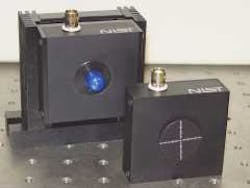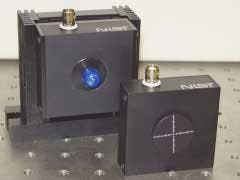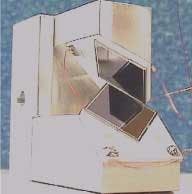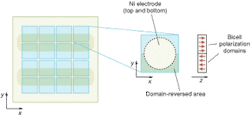Transfer standards address acoustic and angular variance
In developing transfer-standard detectors for radiometric applications, researchers in the optoelectronics division of the National Institute of Standards and Technology (NIST; Boulder, CO) generally use two classes of detector: solid-state photon detectors and thermal detectors, primarily pyroelectric.
The solid-state photon detectors typically provide higher sensitivity and larger dynamic range. But their variation can be quite rapid in some spectral regions, and maximum power or energy tends to be fairly limited. Thermal detectors, on the other hand, offer a flat spectral response and generally higher power levels.
Preferred solid-state detector materials are silicon germanium and indium gallium arsenide, and light-trap detector configurations are used to improve long-term stability and spatial uniformity.
Recent developments include a new light-trap detector for angle insensitive fiberoptic power measurements and a bicell pyroelectric detector that neutralizes acoustic sensitivity without diminishing optical sensitivity (see Fig. 1).
null
Light-trap detectors
Light-trap detectors come in a variety of physical configurations, but the basic idea is to have more than one detector and to angle the detectors to provide multiple bounces to absorb more and reflect less of the light (see Fig. 2). They are essentially transmission traps with a very small amount of light transmitting through the detector and coming out of the back.
null
Bare photodiodes are used for the highest accuracy work to avoid problems due to window transmittance and or inner reflections in the window or between the diode and the window. Typically the internal quantum efficiency for bare photodiodes is very stable. But the reflectance may not be stable, depending upon atmospheric conditions, or the age of the device. So placing them into a trap where all of the light is absorbed eliminates concerns over reflectance.
A trap detector can be calibrated to a higher accuracy than a single photodiode. And an international level of agreement on the order of better than 0.05% has been recently achieved, which is an order of magnitude better than anything previous, according to Christopher Cromer, who leads the laser radiometry effort in Boulder.
Cromer and John Lehman, have recently developed a trap detector for fiberoptic power measurements. It is a transfer standard intended to improve the accuracy of their calibration service for fiberoptic power, initially calibrated with a cryogenic (see "Detector with a pedigree," p. S14). The critical design element for handling the divergent light coming from an optical fiber is responsivity as a function of input angle, such that responsivity does not vary with input angles up to about 30∞.
In the same way that a good transfer standard for laser power or optical power measurements has to have good spatial uniformity so that the detector is insensitive to beam size, the light-trap detector has to be insensitive to beam angle for reliable measurements with parallel beams, free-space beams, and the diverging output of a fiber, Cromer said. Cromer and Lehman achieved accuracies of a few tenths of a percent for fiberoptic power measurements.1
Pyroelectric detectors
The pyroelectrics are thermal detectors that rely upon the inherent properties of the crystal instead of using a thermopile. Light is converted to heat and heat gets converted to charge.
One of the problems with pyroelectric detectors is their sensitivity to any source of strain, such as acoustic vibrations. "All pyroelectric detectors are piezoelectric," Lehman said. "So they are just as good as microphones as they are as optical detectors in principle, and we are trying to remove that sensitivity from it." A manufacturer's figure of merit for a pyroelectric, for instance, generally refers to ideal conditions, when the device is isolated and insulated from the environment both thermally and acoustically.
null
Domain engineering of ferroelectric crystals can compensate for the acoustic sensitivity by creating a bicell (see Fig. 3). The principle involves connecting two detectors electrically in parallel that have equal and opposite acoustic sensitivity. Illuminating both detectors equally gives zero signal. But masking half of the combined bicell detector to light enables the electrical measurement, while eliminating the acoustic effect and providing the noise immunity required for actual applications. The idea of putting two pyroelectric detectors together in opposite polarities is not new, Cromer said. But Lehman's contribution to this effort has been to place both the positively and negatively polled domain areas on the same crystal, which allows the cancellation of acoustic noise to be optimized.2
The current response of a pyroelectric is proportional to the volume average of the change in temperature with respect to time, Lehman said. So the design goal is to decrease the volume without sacrificing area. As the device becomes thinner, however, placing something behind it to support it increases the mass once again, which introduces another design constraint in terms of packaging.
"Thin and freestanding are two things that we are after," Lehman said. "And at the same time in order for these types of detectors to be useful for metrology and other applications, they need to have a reasonably large area." Lehman's thin-film detector grew out of a collaboration with Columbia University (New York, NY) and researchers at Brookhaven Lab (Upton, NY) who figured out a process of crystal-ion slicing to create very thin films of lithium niobate, Lehman said. The resultant detector films have a very high aspect ratio on the order of 300 or 400 to 1, which enables fabrication of detectors that are 10 times thinner and have 10 times greater sensitivity than is possible with conventional lapping and polishing processes.
Users for the NIST pyroelectric detectors include the NPL (National Physical Laboratory in England) and NIST (Gaithersburg, MD). One of the big design issues is in providing antireflection coatings for the metal electrodes that do not significantly diminish the thermal absorption or significantly increase the thermal mass.
According to Cromer, Lehman's gold-black coating provides the spectral flatness out to about 20 µm that is needed by researchers at NIST who are doing spectral irradiance and irradiance measurements and radiation temperature measurements out to very long wavelengths on the order 20 µm and beyond. "Gold-black is still one of those things that remains mysterious," Cromer said. "It's difficult to make and you sort of get a feel for it. But it's difficult to get good gold-black coatings commercially."
Lehman looks forward to further improvements in processing, packaging, and temperature dependence of the devices. "We have made some pretty good steps in terms of yield and handling and so on to make this a practical sort of device, but there is probably more room to improve the technology," he said. "I have a feeling that someone owns the crystal-ion slicing by now, and they probably have figured out better ways but I'm sure they haven't told anybody."
REFERENCES
- J. H. Lehman, C. L. Cromer, Appl. Opt. 41: 6531 (2002).
- J. H. Lehman, A. M. Radojevic, and R. M. Osgood, IEEE Photon. Tech. Lett. 13(8) 51 (Aug. 8, 2001).
Detector with a pedigree
While electrical properties can be measured very accurately, the uncertainty in optical measurements depends on how efficiently optical power can be collected. The NIST transfer-standard detectors essentially take a number of steps to transfer the basic electrical calibration into an optical calibration. The transfer standard facilitates optical measurements because it is traceable to the primary standards, which are traceable to electrical standards.
"The most fundamental optical-power measurements are based on converting optical energy to heat and then measuring the heat by electrical equivalance," Lehman said. "In other words, you compare heat generated electrically with what you absorb optically." The NIST transfer standards start out with primary standards that are generally acquired by relatively large and slow equipment, such as cryogenic radiometers and calorimeters. The NIST researchers use these cumbersome devices to calibrate more user-friendly detectors for routine use that have also been calibrated for all sources of uncertainty such as spatial and spectral variations. Lehman describes the transfer-standard as "a detector with a pedigree."
–HJB



